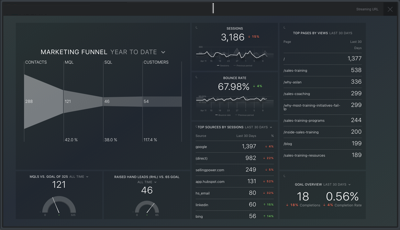The only way to find out how effective your inbound marketing campaigns are is to take measurements and see what the numbers say. However, there are an almost unlimited number of marketing metrics you can track, so how do you know which ones are most valuable to you? And how often should you track them?
The other question that comes up frequently, do you have all the information you need in a consolidated manner so that you have all the information in one place. This helps to make sound business decisions.

Metrics tell stories, and your actions influence how the inbound marketing narrative unfolds.
Following are 5 basic marketing metrics to track to ensure your inbound marketing campaigns deliver good results. You may choose to track other marketing metrics as well, but these should give you a good foundation upon which to build.
1. Website Visits
This is one of the simplest metrics to track, and you should do so at least weekly, if not daily. When you track website visits every day, you can get a very specific picture of what people respond to. For example, if you put up a blog post every day and notice a big spike in traffic one day, that's a good indication you should look at what was posted right before the traffic spike, because it could have prompted a lot of social sharing or an intense comment thread. Tracking visitor numbers daily can also help you identify trends over longer periods, such as which weekdays get the highest and lowest traffic numbers.
2. Visitor to Lead Conversions
Visitor numbers matter, but visitor to lead conversions tell you who visited your page as well as what specific conversion action they completed. How many visitors clicked on your call-to-action form? How many purchased something from your site? Define which conversion actions you want to monitor, and track visitor to lead conversions every week using a platform like HubSpot. You can encourage more conversions with well-designed landing pages, and you can even use analytics tools to find out how visitors arrived at those pages, whether by clicking on an ad or accessing content after a search engine query.
3. Email Engagement
Email engagement should also be tracked weekly. When you send emails to targeted lists of people who have opted into your email newsletters, you know they're already interested in your company. High quality inbound marketing email messages can generate leads and boost your click-through rates. By tracking email engagement weekly, you can go back and review emails that excelled and those that fell flat. As marketing metrics go, the number of people who click on email offers is as straightforward as it gets, because people don't open emails they're not really interested in.
Email marketing can be remarkably effective, if you learn what your customers respond to.
4. Monthly Recurring Revenue
Monthly recurring revenue, or MRR, is a figure you want to grow month to month. It's basically a measure of all your recurring revenue normalized to a monthly time period. It allows you to average your pricing plans and billing periods into a single number that's easy to track. One way to calculate MRR is to multiply your total number of paying customers by the average amount they pay each month. Say you have 10 customers and on average they pay you $100 per month. Then your MRR would be $1,000.
5. Return on Investment
At the end of what you believe to have been a successful inbound marketing campaign, take the time to calculate the return on investment. The simplest way to do this is:
(money the campaign brought in - cost of the campaign) / cost of the campaign
As with MRR, higher ROI is better. By doing a post-mortem ROI calculation after a campaign ends, you can gather data that will tell you which inbound marketing campaigns were most successful, and which underperformed. Knowing this allows you to devote more resources to inbound marketing campaigns with characteristics that have worked well before.
Conclusion
Typically, being able to get all this information in one dashboard has been virtually impossible, but is important if you want to make decisions based upon data and not gut instinct. Think about all of the systems you need to run your marketing department:
- CRM
- Email Service Provider (ESP)
- Google Analytics
- Google Search Console
- Google Adwords
- Point of Sale
- Point of Sale (POS)
- And more...
Keeping up with marketing metrics may not seem all that exciting, and the numbers may not always tell the story you want, but you can't ignore them. Once you've been tracking marketing metrics for several months, you get a better idea of what to expect, and you get better at putting your marketing dollars to work on inbound marketing techniques that deliver. Ultimately, tracking marketing metrics can help you squeeze the most revenue from your marketing resources.

No comments:
Post a Comment